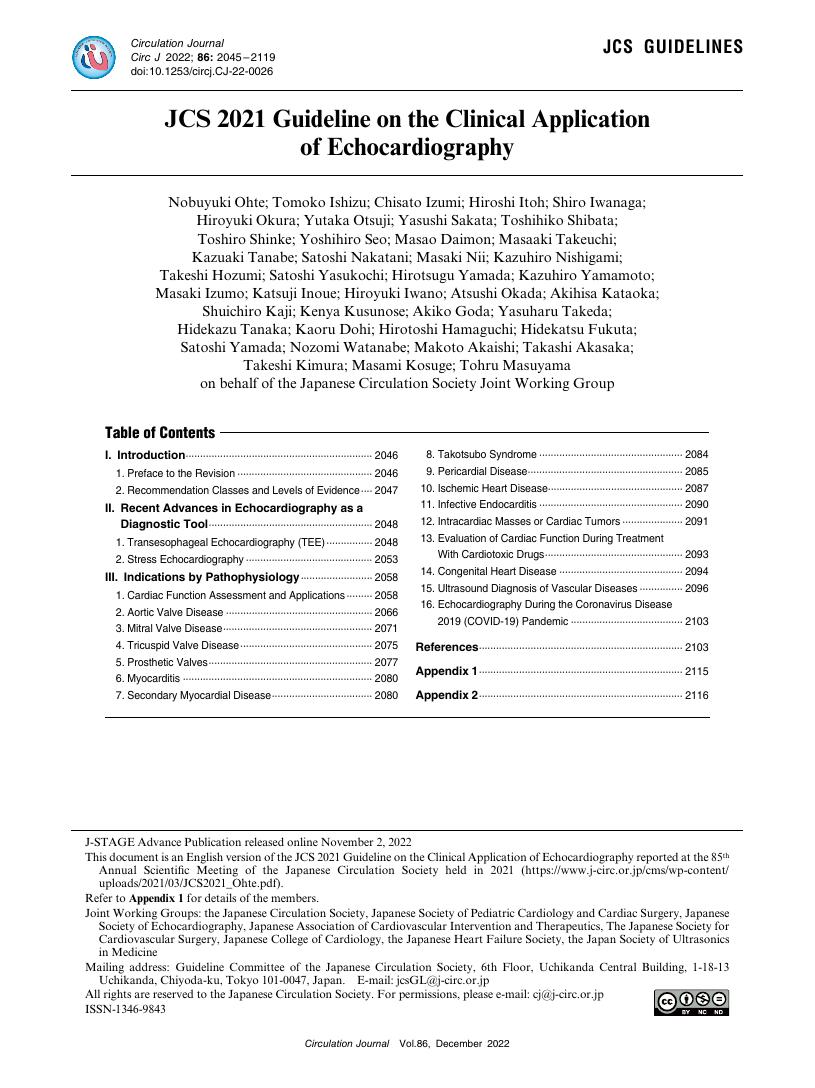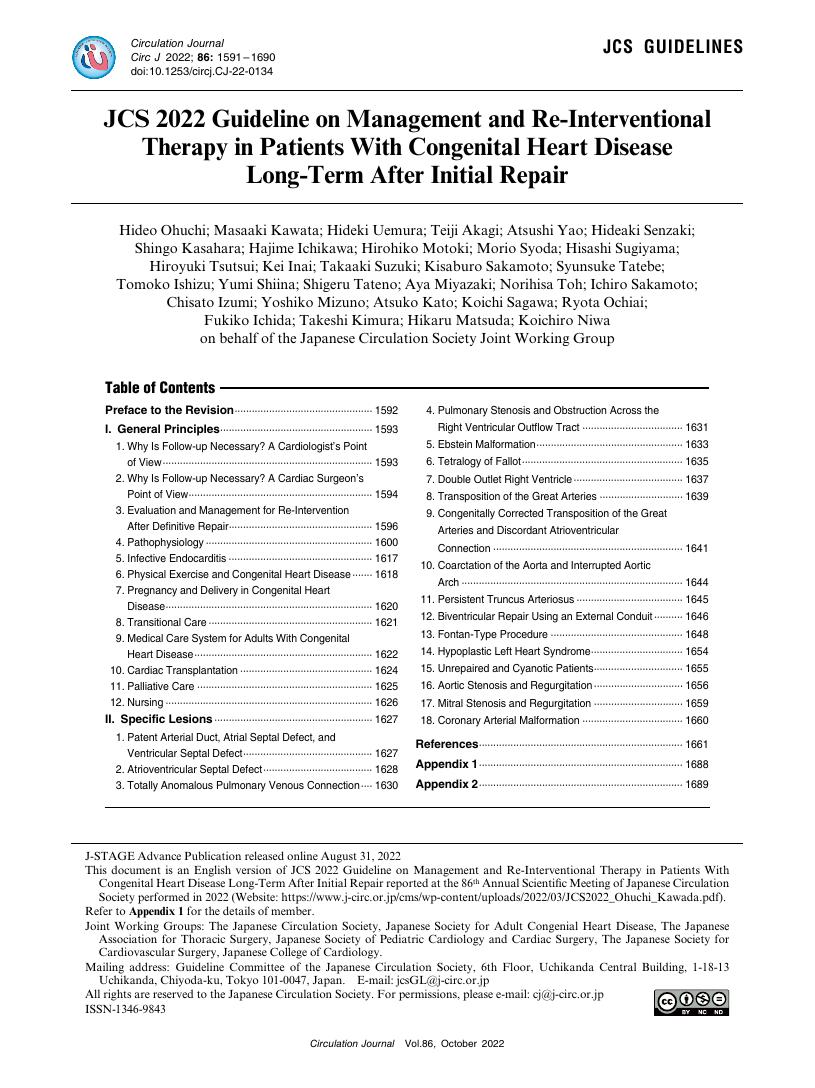- 著者
- Hideo Ohuchi Masaaki Kawata Hideki Uemura Teiji Akagi Atsushi Yao Hideaki Senzaki Shingo Kasahara Hajime Ichikawa Hirohiko Motoki Morio Syoda Hisashi Sugiyama Hiroyuki Tsutsui Kei Inai Takaaki Suzuki Kisaburo Sakamoto Syunsuke Tatebe Tomoko Ishizu Yumi Shiina Shigeru Tateno Aya Miyazaki Norihisa Toh Ichiro Sakamoto Chisato Izumi Yoshiko Mizuno Atsuko Kato Koichi Sagawa Ryota Ochiai Fukiko Ichida Takeshi Kimura Hikaru Matsuda Koichiro Niwa on behalf of the Japanese Circulation Society Joint Working Group
- 出版者
- The Japanese Circulation Society
- 雑誌
- Circulation Journal (ISSN:13469843)
- 巻号頁・発行日
- pp.CJ-22-0134, (Released:2022-08-31)
- 参考文献数
- 1071
- 被引用文献数
- 6
- 著者
- Tomoko Machino-Ohtsuka Kentaro Minami Hiro Yamasaki Tomofumi Nakatsukasa Naoto Kawamatsu Kimi Sato Masayoshi Yamamoto Kazushi Maruo Tomoko Ishizu Yasushi Kawakami Masaki Ieda
- 出版者
- The Japanese Circulation Society
- 雑誌
- Circulation Journal (ISSN:13469843)
- 巻号頁・発行日
- pp.CJ-23-0271, (Released:2023-06-30)
- 参考文献数
- 26
Background: In patients with atrial fibrillation (AF) and severe blood stasis in the left atrial appendage (LAA), dense spontaneous echo contrast (SEC) disturbs the distinct visualization of the LAA interior, thus making thrombus diagnosis inconclusive. We aimed to prospectively assess the efficacy and safety of a protocol for a low-dose isoproterenol (ISP) infusion to reduce SEC to exclude an LAA thrombus.Methods and Results: We enrolled 17 patients with AF and dense SEC (Grade 4 or sludge). ISP was infused with gradually increasing doses of 0.01, 0.02, and 0.03 μg/kg/min at 3-min intervals. After increasing the dose to 0.03 μg/kg/min for 3 min, or when the LAA interior was visible, the infusion was terminated. We reassessed the SEC grade, presence of an LAA thrombus, LAA function, and left ventricular ejection fraction (LVEF) within 1 min of ISP termination. Compared with baseline, ISP significantly increased LAA flow velocity, the LAA emptying fraction, LAA wall velocities, and LVEF (all P<0.01). ISP administration significantly reduced the SEC grade (median) from 4 to 1 (P<0.001). The SEC grade decreased to ≤2 in 15 (88%) patients, and the LAA thrombus was excluded. There were no adverse events.Conclusions: Low-dose ISP infusion may be effective and safe to reduce SEC and exclude an LAA thrombus by improving LAA function and LVEF.
- 著者
- Naomi Akiyama Ryota Ochiai Manabu Nitta Sayuri Shimizu Makoto Kaneko Ayako Kuraoka Michikazu Nakai Yoko Sumita Tomoko Ishizu
- 出版者
- The Japanese Circulation Society
- 雑誌
- Circulation Journal (ISSN:13469843)
- 巻号頁・発行日
- pp.CJ-23-0537, (Released:2023-12-09)
- 参考文献数
- 33
- 被引用文献数
- 1
Background: The end-of-life (EOL) status, including age at death and treatment details, of patients with adult congenital heart disease (ACHD) remains unclear. This study investigated the EOL status of patients with ACHD using a nationwide Japanese database.Methods and Results: Data on the last hospitalization of 26,438 patients with ACHD aged ≥15 years, admitted between 2013 and 2017, were included. Disease complexity (simple, moderate, or great) was classified using International Classification of Diseases, 10th Revision codes. Of the 853 deaths, 831 patients with classifiable disease complexity were evaluated for EOL status. The median age at death of patients in the simple, moderate, and great disease complexity groups was 77.0, 66.5, and 39.0 years , respectively. The treatments administered before death to patients in the simple, moderate, and great complexity groups included cardiopulmonary resuscitation (30.1%, 35.7%, and 41.9%, respectively), percutaneous cardiopulmonary support (7.2%, 16.5%, and 16.3%, respectively), and mechanical ventilation (58.7%, 72.2%, and 75.6%, respectively). Overall, 70% of patients died outside of specialized facilities, with >25% dying after ≥31 days of hospitalization.Conclusions: Nationwide data showed that patients with ACHD with greater disease complexity died at a younger age and underwent more invasive treatments before death, with many dying after ≥1 month of hospitalization. Discussing EOL options with patients at the appropriate time is important, particularly for patients with greater disease complexity.
- 著者
- Nobuyuki Ohte Tomoko Ishizu Chisato Izumi Hiroshi Itoh Shiro Iwanaga Hiroyuki Okura Yutaka Otsuji Yasushi Sakata Toshihiko Shibata Toshiro Shinke Yoshihiro Seo Masao Daimon Masaaki Takeuchi Kazuaki Tanabe Satoshi Nakatani Masaki Nii Kazuhiro Nishigami Takeshi Hozumi Satoshi Yasukochi Hirotsugu Yamada Kazuhiro Yamamoto Masaki Izumo Katsuji Inoue Hiroyuki Iwano Atsushi Okada Akihisa Kataoka Shuichiro Kaji Kenya Kusunose Akiko Goda Yasuharu Takeda Hidekazu Tanaka Kaoru Dohi Hirotoshi Hamaguchi Hidekatsu Fukuta Satoshi Yamada Nozomi Watanabe Makoto Akaishi Takashi Akasaka Takeshi Kimura Masami Kosuge Tohru Masuyama on behalf of the Japanese Circulation Society Joint Working Group
- 出版者
- The Japanese Circulation Society
- 雑誌
- Circulation Journal (ISSN:13469843)
- 巻号頁・発行日
- vol.86, no.12, pp.2045-2119, 2022-11-25 (Released:2022-11-25)
- 参考文献数
- 460
- 被引用文献数
- 16
- 著者
- Masayoshi Yamamoto Yoshihiro Seo Tomoko Ishizu Isao Nishi Yoshie Hamada-Harimura Tomoko Machino-Ohtsuka Kimi Sato Seika Sai Akinori Sugano Kenichi Obara Kazutaka Aonuma
- 出版者
- 日本循環器学会
- 雑誌
- Circulation Journal (ISSN:13469843)
- 巻号頁・発行日
- pp.CJ-17-0240, (Released:2017-06-06)
- 参考文献数
- 27
- 被引用文献数
- 9
Background:Although experimental animal studies report many pleiotropic effects of dipeptidyl peptidase-4 inhibitors (DPP-4i), their prognostic value has not been demonstrated in clinical trials.Methods and Results:Among 838 prospectively enrolled heart failure (HF) patients hospitalized for acute decompensated HF, 79 treated with DPP-4i were compared with 79 propensity score-matched non-DPP-4i diabetes mellitus (DM) patients. The primary endpoint was all-cause mortality; the secondary endpoint was a composite of cardiovascular death and hospitalization. During follow-up (423±260 days), 8 patients (10.1%) in the DPP-4i group and 13 (16.5%) in the non-DPP-4i group died (log-rank, P=0.283). The DPP-4i group did not have a significantly higher rate of all-cause mortality (log-rank, P=0.283), or cardiovascular death or hospitalization (log-rank, P=0.425). In a subgroup analysis of HF with preserved ejection fraction (HFpEF; n=75), the DPP-4i group had a significantly better prognosis than the non-DPP-4i group regarding the primary endpoint (log-rank, P=0.021) and a tendency to have better prognosis regarding the secondary endpoint (log-rank, P=0.119). In patients with HF with reduced EF (n=83), DPP-4i did not result in better prognosis.Conclusions:DPP-4i did not increase the risk of adverse clinical outcomes in patients with DM and HF. DPP-4i may be beneficial in HFpEF.
- 著者
- Tomofumi Nakatsukasa Tomoko Ishizu Masumi Ouchi Nobuyuki Murakoshi Kimi Sato Masayoshi Yamamoto Kunio Kawanishi Yoshihiro Seo Masaki Ieda
- 出版者
- The Japanese Circulation Society
- 雑誌
- Circulation Journal (ISSN:13469843)
- 巻号頁・発行日
- vol.86, no.12, pp.2029-2039, 2022-11-25 (Released:2022-11-25)
- 参考文献数
- 35
- 被引用文献数
- 4
Background: Elevated central venous pressure (CVP) in heart failure causes renal congestion, which deteriorates prognosis. Sodium glucose co-transporter 2 inhibitor (SGLT2-i) improves kidney function and heart failure prognosis; however, it is unknown whether they affect renal congestion. This study investigated the effect of SGLT2-i on the kidney and left ventricle using model rats with hypertensive heart failure.Methods and Results: Eight rats were fed a 0.3% low-salt diet (n=7), and 24 rats were fed an 8% high-salt diet, and they were divided into 3 groups of untreated (n=6), SGLT2-i (canagliflozin; n=6), and loop diuretic (furosemide; n=5) groups after 11 weeks of age. At 18 weeks of age, CVP and renal intramedullary pressure (RMP) were monitored directly by catheterization. We performed contrast-enhanced ultrasonography to evaluate intrarenal perfusion. In all high-salt fed groups, systolic blood pressure was elevated (P=0.287). The left ventricular ejection fraction did not differ among high-salt groups. Although CVP decreased in both the furosemide (P=0.032) and the canagliflozin groups (P=0.030), RMP reduction (P=0.003) and preserved renal medulla perfusion were only observed in the canagliflozin group (P=0.001). Histological analysis showed less cast formation in the intrarenal tubule (P=0.032), left ventricle fibrosis (P<0.001), and myocyte thickness (P<0.001) in the canagliflozin group than in the control group.Conclusions: These results suggest that SGLT2-i causes renal decongestion and prevents left ventricular hypertrophy, fibrosis, and dysfunction
- 著者
- Hideo Ohuchi Masaaki Kawata Hideki Uemura Teiji Akagi Atsushi Yao Hideaki Senzaki Shingo Kasahara Hajime Ichikawa Hirohiko Motoki Morio Syoda Hisashi Sugiyama Hiroyuki Tsutsui Kei Inai Takaaki Suzuki Kisaburo Sakamoto Syunsuke Tatebe Tomoko Ishizu Yumi Shiina Shigeru Tateno Aya Miyazaki Norihisa Toh Ichiro Sakamoto Chisato Izumi Yoshiko Mizuno Atsuko Kato Koichi Sagawa Ryota Ochiai Fukiko Ichida Takeshi Kimura Hikaru Matsuda Koichiro Niwa on behalf of the Japanese Circulation Society Joint Working Group
- 出版者
- The Japanese Circulation Society
- 雑誌
- Circulation Journal (ISSN:13469843)
- 巻号頁・発行日
- vol.86, no.10, pp.1591-1690, 2022-09-22 (Released:2022-09-22)
- 参考文献数
- 1071
- 被引用文献数
- 6
- 著者
- Masayoshi Yamamoto Yoshihiro Seo Tomoko Ishizu Isao Nishi Yoshie Hamada-Harimura Tomoko Machino-Ohtsuka Kimi Sato Seika Sai Akinori Sugano Kenichi Obara Kazutaka Aonuma
- 出版者
- 日本循環器学会
- 雑誌
- Circulation Journal (ISSN:13469843)
- 巻号頁・発行日
- vol.81, no.11, pp.1662-1669, 2017-10-25 (Released:2017-10-25)
- 参考文献数
- 27
- 被引用文献数
- 9
Background:Although experimental animal studies report many pleiotropic effects of dipeptidyl peptidase-4 inhibitors (DPP-4i), their prognostic value has not been demonstrated in clinical trials.Methods and Results:Among 838 prospectively enrolled heart failure (HF) patients hospitalized for acute decompensated HF, 79 treated with DPP-4i were compared with 79 propensity score-matched non-DPP-4i diabetes mellitus (DM) patients. The primary endpoint was all-cause mortality; the secondary endpoint was a composite of cardiovascular death and hospitalization. During follow-up (423±260 days), 8 patients (10.1%) in the DPP-4i group and 13 (16.5%) in the non-DPP-4i group died (log-rank, P=0.283). The DPP-4i group did not have a significantly higher rate of all-cause mortality (log-rank, P=0.283), or cardiovascular death or hospitalization (log-rank, P=0.425). In a subgroup analysis of HF with preserved ejection fraction (HFpEF; n=75), the DPP-4i group had a significantly better prognosis than the non-DPP-4i group regarding the primary endpoint (log-rank, P=0.021) and a tendency to have better prognosis regarding the secondary endpoint (log-rank, P=0.119). In patients with HF with reduced EF (n=83), DPP-4i did not result in better prognosis.Conclusions:DPP-4i did not increase the risk of adverse clinical outcomes in patients with DM and HF. DPP-4i may be beneficial in HFpEF.

